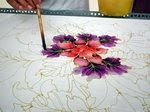
Batik is a wax resist fiber art. Hot wax is applied to fabric in a design. The wax serves as a resist, preventing the dye from reaching the fabric where it was applied. This technique can be applied in layers with different colors.
The Batik effect is unique in that the wax cracks during handling, either intentionally or not. In each dye bath, the cracks in the wax allow the dye to reach the fabric creating the unique batik effect . Batik can be done on cottons, silks and other natural fabrics. "Faux" batik employs other types of resists, particularly water soluble ones, that are easier to remove than wax, but never quite achieve the same beautiful crackling. Dharma Procion MX Fiber Reactive Dyes are the dye of choice for batik on cotton because they are used with cold water.
 Batik masters employ the process of repeated waxing and tub dyeing to achieve their final result. This method involves an understanding of color mixing and overdyeing, as each layer of dye is applied over the last, producing a new color. After many different applications, the background tends towards dark brown, black or grey. The waxed areas remain the lighter shades produced by each individual dye application and combinations thereof.
Batik masters employ the process of repeated waxing and tub dyeing to achieve their final result. This method involves an understanding of color mixing and overdyeing, as each layer of dye is applied over the last, producing a new color. After many different applications, the background tends towards dark brown, black or grey. The waxed areas remain the lighter shades produced by each individual dye application and combinations thereof.
No comments:
Post a Comment